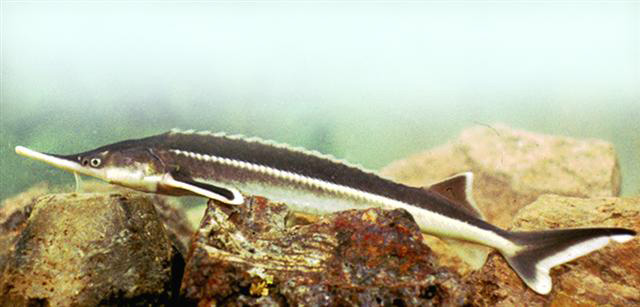| Acipenseridae (Sturgeons), subfamily: Acipenserinae |
| 125 cm TL (male/unsexed); max.weight: 16 kg; max. reported age: 20 years |
|
demersal; freshwater; brackish; depth range - 1 m, potamodromous |
| Eurasia: rivers draining to Black, Azov and Caspian Seas; Siberia from Ob eastward to Yenisei drainages. Introduced throughout Europe, without formation of self-sustaining populations. |
|
Dorsal spines (total): 13-13; Dorsal soft rays (total): 28-28; Anal spines: 9-9; Anal soft rays: 14-18. Back and flanks are beige. Five rows of scutes : 12-17D, 57-71L, 10-19V. Ventrals and laterals are very light-colored, nearly white. Narrow and pointed snout with four long and fringed barbels. Inferior lip clearly slit (Ref. 40476). Can be diagnosed from congeners in Europe by having 56-71 lateral scutes, first dorsal scute not fused with head, barbels fimbriate, lower lip interrupted in middle and 11-27 gill rakers (Ref. 59043). |
| A fluvial fish which inhabits rivers and their tributaries (Ref. 9696). Occurs in large rivers, usually in the current and in deep water. Moves to flooded areas to feed (Ref. 59043). Chiefly potamodromous (Ref. 58897). Like other sturgeons, it aggregates in bottom holes in winter and exhibits little activity. In spring, when ice breaks, it rises from the bottom holes and moves upstream for spawning (Ref. 593). Spawns in habitats with strong-current on gravel, rarely on gravel-sand bottom or in flooded sites. Juveniles stay in riverine habitats during their first summer. Classified as endangered species. Anadromous populations are now extirpated; local populations are still surviving in most parts of range (Ref. 59043). |
|
Endangered (EN); Date assessed: 14 September 2019 (A2cde) Ref. (130435)
|
| harmless |
|
Type localities of: Acipenser kamensis, Kama River; Acipenser ruthenus var. grisescens and Acipenser ruthenus var. leucotica Nishni-Novgorod (no types known); probably by Acipenser kankreni; Acipenser lovetzkyi, no locality; Sterledus ruthenus var. sibiricus, middle and lower Angara River, Siberia; Acipenser ruthenus rutzskyi, Upper Ob River, Siberia (Ref. 124648).
Distributed in the basins of the Black, Caspian, White, Barents and Kara seas and the Sea of Azov (Ref. 26334). This has been translocated to areas within the country for aquaculture and stocking in open waters where it has become locally established (Ref. 45022). Introduced in Pechora drainage in 1928-1950 and in Lake Ladoga basin (Ref. 59043). Also Ref. 683, 55804, 86838. EurRus |
Source and more info: www.fishbase.org. For personal, classroom, and other internal use only. Not for publication.

